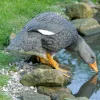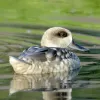
Blue Duck (Hymenolaimus malacorhynchos)
Species name
- Dutch name:
- Nieuw-zeelandse blauwe eend
- English name:
- Blue Duck
- German name:
- Saumschnabelente
- French name:
- Hyménolaime bleu
- Scientific name:
- Hymenolaimus malacorhynchos
Scientific classification
- Order:
- Anseriformes
- Family:
- Anatidae
- Onderfamilie:
- Tadorninae
- Genus:
- Hymenolaimus
Description
- Description:
Male:
Virtually whole plumage is slaty grey with bluish sheen. Head a little darker and crown brown grey, though brownish tinge often slight or even absent. Breast paler grey heavily mottled with reddish brown elongated blotches, which often arranged, at least in center of breast, into ill-defined streaks running down onto upper belly, mottling petering out onto anterior flanks; undertail converts dull chestnut. Smudgy black mottling on mantle and scapulars. Upper wings same uniform blue-grey color, but inner secondaries have black edges and outer six secondaries have narrow white tips; under wings uniform paler grey, with white tips to secondaries showing. Bill pale pinkish white with black nail, and black pendent lobes of skin on each sides of tip; nostrils blackish. Legs and feet light brown with darker brown patches.Female:
Identical to male but, mottling on breast less extensive and rarely reaching flanks or belly. Wings, tail and bare parts as male.Juvenile:
Lacks bluish sheen; mottling on breast absent at first and then brown, lacking reddish color, and more limited in extent then female. Upper wing converts with brownish tinge. Bill very pale flesh grey, with black nail, skin lopes and stripe down center of upper mandible almost to tip.
Adult plumage acquired after first year.
- Behaviour:
Blue ducks are monogamous and fiercely territorial; the territory and pair bond are maintained throughout the year.
Standard Measurements
- Body Length (cm):
- The male (drake) of the Blue Duck measures approximately 53-56 centimeters. The female measures approximately 53-56 centimeters.
- Body Weight (grams):
- The male will weight about 880-920 gram. The female will weight about 750-790 gram.
The weight is notoriously variable and can only be used as indication!
- Subspecies:
There are two subspecies:
- H. m. malacorhynchos - western South Island, New Zealand
- H. m. hymenolaimus - central North Island, New Zealand
- Note:
These ducks should be kept in a seperate enclosure, with flowing water. Pairs are normally formed in the first year of life, soon after fledging, and considerable problems have been encountered with aggression within pairs. There have also been fertility problems in captivity, with generally low fertility. Work has now started on the use of artificial insemination to overcome this problem.
Parent incubation has been successful. However, ducklings left with their parents died after only a few days from Acanthocephala Infection (Thorny-headed worms) ingested in freshwater shrimps Gammarus spp.. Artificial incubation and rearing has been successful, with ducklings reared without swimming water initially, being given access to trays of water in outside pens from ten days old.
- Breeding:
- The female Blue Duck usually lays from 5-6 creamy-white to pale buff eggs and incubates them for 33-35 days.
- Artificial incubating:
The ideal relative humidity for incubating most waterfowl eggs is 55% (ground nesters) and 40% (cavity nesters). The temperature is usually 37.4°C. Set ventilation as recommended by the incubator manufacturer. Eggs must be turned, either automatically or by hand, a minimum of 4 times a day. As the duckling develops there is a loss of water from the egg and the air sac gets bigger. In normal development of an egg with a 33-35 days incubation, the air sac occupies about a third of it three days earlier. Cleanliness is vital and ideally eggs should be moved to a separate hatcher at this point, where the humidity should be increased to 65% and even higher once they have pipped internally.
- Bird banding:
- Recommended closed leg band ring size for the Blue Duck is - mm.The leg band ring can only be applied on a young duck at around - days old.
- It doesn't matter what leg that you band, but it's good to have a consistent system. Suggested: Left leg = Female, Right leg = Male
- Maintenance food:
-





Floating full food for all sea ducks, green ducks, eider ducks and geese, especially in the moulting and breeding phase ideally suited. Packed with wholesome raw materials, natural vitamins and trace elements, this performance food with a protein content of 30% forms the basis for lifelong vitality.







Floatable special complete food for sea birds with the highest nutritional requirements. Each chunk contains the complete nutrient spectrum. The high protein content of 35% ensures a healthy and species-appropriate diet. Spiral algae give a more magnificent coloration of plumage and sea salt promotes the salt gland.







